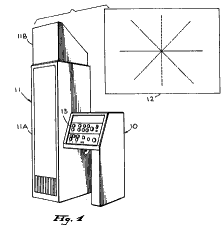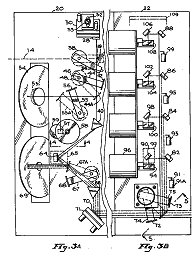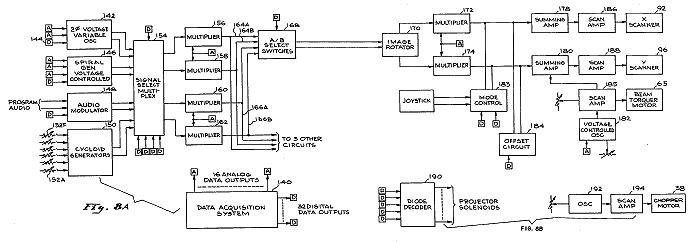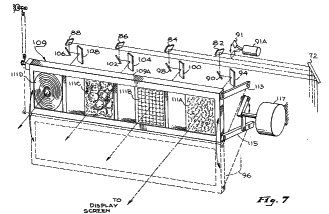![]()
About LaseriumLaseriumģ was the first regularly-scheduled, long-term laser show (e.g., not at a concert or fair). It was developed by Ivan Dryer, a filmmaker who realized that motion pictures and video could not adequately capture the magic of laser -- it had to be experienced live. This, and his genius to present lasers in the enveloping atmosphere of a planetarium, made Laserium a sensation when it premiered at Griffith Park (Los Angeles) on November 19, 1973. Laserium ran there for 28 years, making it the longest-running theatrical attraction in Los Angeles, and the longest-running laser show in the world. The final Griffith Park performance was January 5, 2002, two days before the planetarium was shuttered for renovations. Over the past three decades, Laserium shows have been presented in 45 cities around the world. Much more information about Laserium and its parent company, Laser Images Inc., is at the Laserium website. About this pageThe reminiscence below is from former laserist Brian Wirthlin. It was posted to the Laserist List on July 28, 2002, and is reprinted here by permission. Brian also posted another message about Laserium and digital graphics, which is available on this page. The drawings below are from the patent for Laserium's earliest projector, the Mark 4. The drawings have been scattered throughout the page and do not necessarily reflect what is being discussed in the surrounding text. Click on any drawing to see a larger-size view. |
 Laserium did its first show at Griffith Park with a custom "projector" that I'm
sure is reminiscent of many company's first projectors. (Except it took like 4
people to do Danube.) It was not preserved.
Laserium did its first show at Griffith Park with a custom "projector" that I'm
sure is reminiscent of many company's first projectors. (Except it took like 4
people to do Danube.) It was not preserved.
Their first standard projector was the Mark 4. Obviously there were some false starts. The Mark 4 had a single scan glass "tray", Z60 Scanners (must have been designed for chart recorders), a 4 position optical effect bank, and an optical bench that housed 2 prisms and a "beam torquer" scanner for color modulation, three more optical effects, and the chopper mounted behind the optical bench. The control panel was bolted on to the side of the 19" equipment rack that contained the laser and supported the optical head. It was common for the laserist to grasp the control panel and shake the entire projector during 'Neptune'.
Obviously this was in the days before PCAOMs. Their "Color Mod" system was made up of a galvo between 2 prisms. The raw beam was passed through the first prism to disperse the various lines. This diverging wedge of light was reflected from the galvo's mirror into the second prism. This prism was adjusted to make the individual beams parallel to each other. The result was a ribbon of discrete beams that could be moved across the scanner "pickoffs" and optical effect apertures. While much less capable than today's PCAOMs it was arguably quite efficient and had a pleasing symmetry. The "chopper" was a Z60 galvo with a double slotted "can" style shutter. An EM20 galvo was used for intensity control on the Mark 6. (I'm not sure about the Mark 4.)
 The Mark 6 with the introduction of Laserium II replaced the Mark 4
projector. This projector became Laser Images' workhorse for the next decade+.
Optically it boasted 4 sets of G124 Scanners, a second optical effects bank and
3 scan glasses per scanner. (Now individually addressable) Electrically the
projector had evolved also, but much of the evolution was to support a digital
recording R&D project that never saw the light of day.
The Mark 6 with the introduction of Laserium II replaced the Mark 4
projector. This projector became Laser Images' workhorse for the next decade+.
Optically it boasted 4 sets of G124 Scanners, a second optical effects bank and
3 scan glasses per scanner. (Now individually addressable) Electrically the
projector had evolved also, but much of the evolution was to support a digital
recording R&D project that never saw the light of day.
This projector also introduced Laserium's first digital image. Singular, that's ONE digital image. It wrote 'Laserium'. People were impressed. The card was built on a standard 44 pin Vector Wirewrap board and was called the Digital Programmed Image Generator. It was referred to as D-PIG card. (This may have been an editorial comment.) In addition there were about 25 other circuit boards (mostly wire wrap) split between 2 card cages. This doesn't include the scan amp card cage or the odd circuit board 'hanging in space' here and there. The controls were mounted on 19" panels. These were mounted at about 30 degrees from horizontal with a joystick on either side. The second joystick allowed image rotation independent of traditional joystick motion. It's important to note that there were no microprocessors involved at this point. The points to spell out laserium were digitized on graph paper, manually loaded, (into an eight? board wire wrapped master's thesis project) and burned to an EPROM. The image was treated as a fixed cycloid. Discrete electronics addressed the EPROM/DACs.
Laserock introduced a 'digital' image generator. 'Digital' because the analog output signals were generated by 555 timers and discrete component D/A converters. Three oscillators with quadrature sine outputs, amplitude modulation, frequency modulation, and one osc. also had a quadrature triangle wave output. (Of little value given non-feedback scanners.) Master gain, individual gain, AM gain, FM gain, symmetry, polarization, and ten turn frequency controls were the user interface. These controls were mounted in the cover of the upper card cage.
The "Rock Turret" was the second significant upgrade. The cover for the optical bench had a raw beam aperture originally used in 'Heart of the Sun' in Laserium 1. This cover was replaced with a new one supporting five-position special effect turret with Hall effect position sensing. An independent intensity control was added for this effect.

Most of the circuit boards in Laser Images' equipment had 4 letter acronyms. The Digital Offset Generator board's was shortened to three. Calling it the DOG card may have simply followed in the great tradition of D-PIG card. It could do several images per scanner as well as static and dynamic offsets. The popcorn effect produced by earlier equipment suffered in existing shows due to the connection of offset gain to the DOG card's multiplying DACs. The DOG card was limited by it's small memory 2k? of RAM, 2k? of ROM. This was a function of board space since in addition to memory a 6502 cpu, glue chips, and 8 D/A converters had to fit on a "standard" Vector wirewrap board. (That's about 4 x 5 inches of board space.)
Another Turret was added to the optical head for Starship. The Fiber Optic Turret was hung off the right side of the projector and was illuminated by a 3' fiber optic bundle. The fiber optic plugged into the last optical effect position on the 1st effects bank. The fiber optic was supported by a microscope stage in the turret that was controlled by the laserist using a closed loop position control.
The scanner bank and both optical effect banks received EM20 intensity controls. Independent motor controls were added for both optical effect bank primary and secondary motor channels. The controls were hung above the right hand joystick.
I know something was done but I can't remember precisely what. Almost certainly the adjustable filters to smooth out the joystick signals were added here. Perhaps the conductive plastic fine frequency adjustment pots were added here also.
My memory is getting dim. I think there was another set of mods in here but they may have been entirely electronic. At some point the three wire wrap circuit boards that comprised the data decoder were replaced with 1 PC board. This was simply to free up space for something else that I can't remember...
 The Beatles Show modifications were significant. An AOM replaced the Old Z60
chopper. A S-100 format Accessory Digital Image Generator was added in a box to
mount under the lower card cage. A fair amount of wiring changes to interface
the above, and tapping into existing signals to drive them was required. If
memory serves the ADIG was a single channel device unlike the DOG Card that
could output different images to each scanner.
The Beatles Show modifications were significant. An AOM replaced the Old Z60
chopper. A S-100 format Accessory Digital Image Generator was added in a box to
mount under the lower card cage. A fair amount of wiring changes to interface
the above, and tapping into existing signals to drive them was required. If
memory serves the ADIG was a single channel device unlike the DOG Card that
could output different images to each scanner.
Laser Images attempted to open the Beatles show at the same time in all venues. It premiered the week before Christmas in a year when Christmas Eve/Day and New Years Eve/Day fell on Friday and Saturday. (For anyone not familiar with Standard Operating Procedures for Planetarium Operations (SOP-PO) Section 4, Paragraph 17, Line 4 clearly states: "Ainít nobody going to be here, were closed.")
You will notice the projector was modified extensively as time progressed. It's hard to believe that Laser Images' dominance could be a disadvantage, but size has its own implications. Laser Images grew constantly in the early years. They had 14? planetarium installations at their zenith. But the foundation of the business was continuous growth. When the growth stopped they began to fall apart. In the long run it was Griffith Park that allowed it to survive in any form.
Despite being less than state of the art the projectors were complex, and the show library valuable. They couldn't just throw compatibility away. The temptations to reduce the cost of introducing new shows, and maintain backward compatibility were pervasive. Obviously they were constantly searching or playing or experimenting with new effects, but when they found one they had to make it for all of those projectors.
The original Laserium show's hardware, software and music evolved in front of an audience for the first two years. St. Louis was their 5th or 6th market. They opened with Laserium 1 in 1975 and 92 weeks later they were still selling out 380 seats per show on the weekends. They never had a show with that kind of staying power again.
-- Brian
Postscript: Laserium's Mark 4 projector was patented and therefore available for download on the U.S. Patent office web site. (You may have to download a special tiff plugin to see the drawings.)
The Laserium projector patentThe Laserium patent is # 4,006,970, entitled "Laser Light Image Generator". It was filed July 14, 1975 and was issued February 8, 1977. Listed inventors are Dan Slater, Ivan Dryer and Charles W. McDanald. The abstract states:
Some images from the patent are above -- click to see a larger-size view. A full copy of the patent can be seen at the U.S. Patent Office site. Enter the patent number in the search query box. |
![]()
Laser Displays Inc.
Laserium
Patrick Murphy (pre-Pangolin)
Laserist List histories
Links to other lasershow history websites